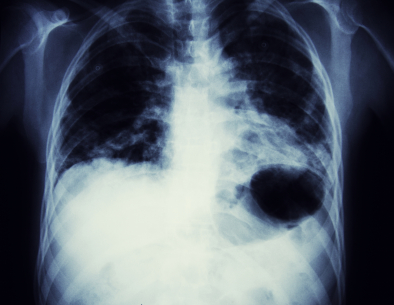Treatment
Medical Treatment Options for Mesothelioma
By Dr. Tracey Roizman
Your best chance for surviving mesothelioma requires that you begin treatment as soon as possible after being diagnosed.
You have three available treatment options: surgery, chemotherapy and radiation. Often, it is to your advantage to be treated with more than one of these — however, that will depend on two main factors: how advanced the mesothelioma is and your overall state of health.
Mesothelioma Surgery
Some mesothelioma surgery procedures are intended to rid your body of the cancer. Others alleviate breathing difficulty (dyspnea), or relieve pain.
If you’ve been diagnosed with early-stage mesothelioma, you may be a candidate for pleurectomy. In this procedure, a surgeon removes the tumor along with the pleura — the membrane that lines the lung and chest wall. This restores space for the lung to function. The risks of a pleurectomy include air leakage from the lung, infection around the lung, and damage to the nerve that controls the breathing muscle.

Medical research finds that EPP offers the longest survival time of any mesothelioma treatment option. There is 5% risk that you won’t survive the surgery.
Draining Chest Cavity Fluid
You may be unable to withstand the stress of major surgery or the cancer may have reached an advanced stage. In these cases, your surgeon might suggest a procedure to drain from your chest cavity the buildup of fluid caused by the disease.
This helps make your breathing more comfortable. There are two ways fluid can be drained.
One is with an instrument called a thoracoscope. After the fluid is drained, the doctor uses the same instrument to administer chemotherapy or replace the fluid with a substance that seals the lung to the chest wall and prevents fluid from reaccumulating.
The second way fluid can be drained is with a PleurX Catheter — an indwelling catheter. As the name indicates after insertion, the catheter remains in place. This lets is continually drain excess fluid. You self-maintain the catheter at home, but careful monitoring is required to prevent infection and other complications.
Because mesothelioma tends to spread so aggressively to surrounding structures, surgery alone rarely removes it entirely. For this reason, surgery is usually combined with chemotherapy and/or radiation.
Mesothelioma Chemotherapy
Your doctor may recommend treating you with chemotherapy drugs. These are typically administered in multiple courses. The drugs may be administered either directly into the area where the cancer is established or by infusion into your bloodstream — which is known as systemic chemotherapy.
Two different chemotherapy drugs often are given in combination. A clinical trial on combination therapy used two of the most established mesothelioma drugs. This improved survival time by 30 percent, compared to the use of one drug by itself.
Chemotherapy drugs are highly toxic to cancer cells. Unfortunately, they are highly toxic to normal, healthy cells as well.
Side effects can include nausea, vomiting, liver and kidney damage, and numbness and tingling in the hands and feet. These side effects are occasionally severe enough to impair the progress of your treatment by making it necessary to delay the start of the next course.
The effectiveness of standard chemotherapy against mesothelioma is limited, with response rates in clinical studies rarely topping 25 percent.
Mesothelioma Radiation Therapy

Radiation therapy can be used as a standalone treatment or together with other treatments. Performed after early-stage surgery, it is highly effective at reducing local recurrence rates. Radiation is commonly administered in combination with chemotherapy.
Doctors use radiation therapy to reduce tumor size. It also provides relief of symptoms, such as pain and breathing difficulty in advanced stages.
A newer radiation technique is Intensity Modulated Radiation Therapy, or IMRT.
It targets X-rays directly at cancer cells, reducing the exposure of surrounding structures. However, IMRT has been associated with increased risk for metastasis — the spread of cancer to other parts of the body.
Mesothelioma Molecular-Targeted Therapy
Emerging from new-generation, cutting-edge chemotherapy agents are molecular-targeted therapies. These target functions specific to mesothelioma cells while sparing healthy cells. Some molecular-targeted therapies disable cancer cell DNA. Others therapies inhibit key enzymes or cell-to-cell signaling pathways that cancer cells rely on to grow and multiply.
One innovative technique uses a neutralized virus to gain entry into the body and selectively deliver radioactive iodine to cancer cells. Although promising, these techniques are still largely in preliminary developmental stages.
There are not many human clinical trials to support them and the trials that have been conducted have mixed results.
Mesothelioma Treatment Outlook
The American Cancer Society reports a five-year survival rate of five to 10 percent for patients with mesothelioma. However, treatment advances on all fronts are slowly improving these numbers.
Early detection screening tools are being developed, which should contribute to further increases in mesothelioma survival. Until then, your best means for ensuring the greatest possible outcome is to opt for the most current and appropriate medical treatments at the earliest stage you can.
One of our fundamental missions is to help patients get treatment for their disease. To learn more about your outlook or get connected with a treatment facility, contact our patient support center today.

